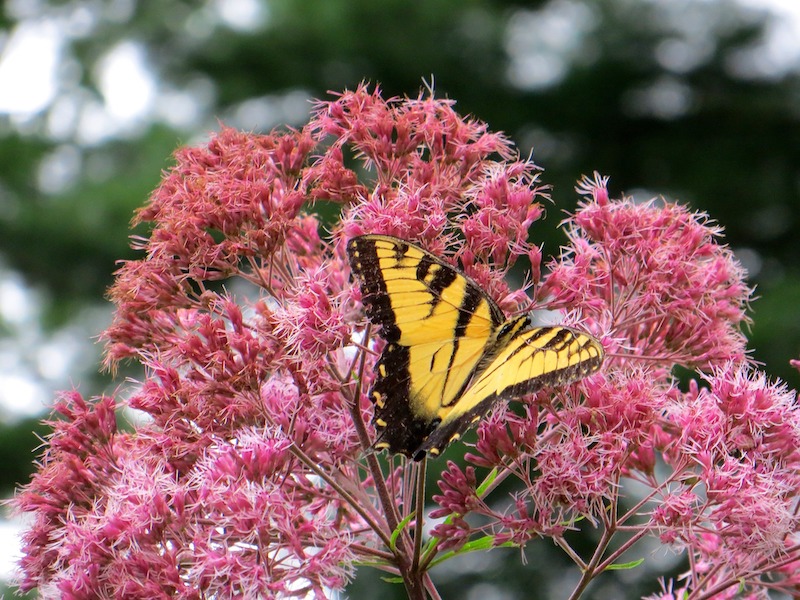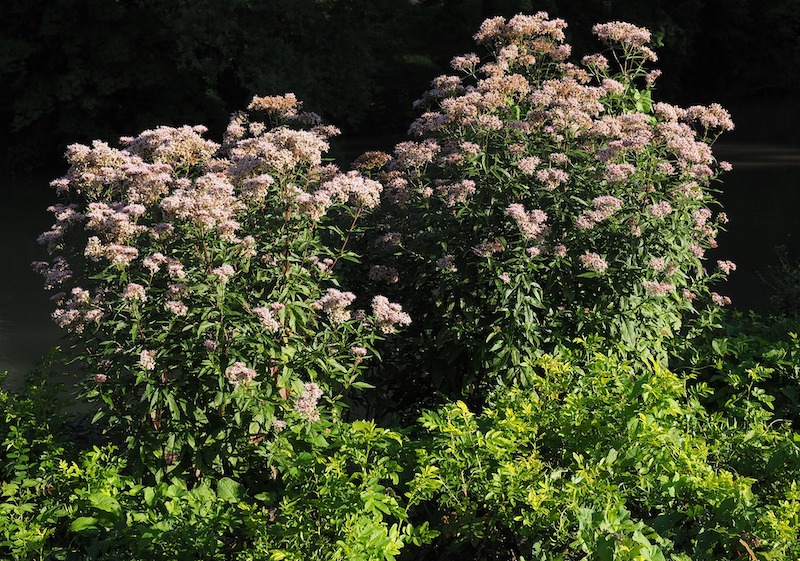Growing Joe Pye Weed
A member of the Asteraceae family, Joe Pye weed is anything but a weed. Rather, this herbaceous perennial, native to North America, is a highly prized wildflower consisting of long stalks topped with lush clusters of delicate cut-flower quality florets and foliage. The blooms can come in baby pink, mauve, lavender, orchid, or ivory florets and are a pollinator’s dream from summer until fall. Teeming with rounded, gossamer petals, the flowers have a yummy vanilla bean fragrance. Attracting bees, butterflies, and birds, Joe Pye Weed amps up the pollinator in any pollinator garden.

Native to wet locales, Joe Pye Weed is ideally suited for water gardens and the banks of streams and ponds as well. Reaching 3 to 7 feet tall and 1.5 feet to 4 feet wide, Joe Pye Weed offers height, color, and texture to beds and privacy screens. Two common species, Eupatorium maculatum, or spotted Joe Pye weed, and Eupatorium purpureum, or purple Joe Pye weed, are frequently added to native gardens throughout the United States and Canada. Cold hardy in zones 4 to 8, this vigorous wildflower is adaptable, deer tolerant, relatively disease resistant, easy to grow, and low maintenance. It is not only a fantastic option for pollinators and the environment but also for amateur gardeners looking for a headache-free way to add beauty and fragrance to a landscape, deck, or patio.
Planting Joe Pye Weed
Joe Pye Weed grows upright and bushy. While tolerating partial sun, Joe Pye Weed may grow too leggy under this condition. To encourage strong, upright growth, choose a location that gets at least 6 hours of full sun. Not fussy about the type of soil, this versatile wildflower tolerates sandy substrates and soil with lots of clay. That noted, it prefers rich, loamy soils that tend to remain constantly moist. Amend your native soil with compost if it doesn’t fit this profile. Joe Pye Weed is not picky about soil pH and will grow in acidic, neutral, and alkaline substrates.
Plant Joe Pye weed after the frost date in spring by digging a hole two times as wide as the root ball and about as deep. Plant the root ball in the hole and backfill. Add two to three inches of mulch atop the soil to prevent water loss. Space each plant two to four feet apart. Plant this beauty with bee balm, coneflowers, and Russian sage.

Watering Joe Pye Weed
The secret to successfully growing Joe Pye weed is maintaining the proper moisture level in the soil. Since Joe Pye weed is commonly found growing along streams, lakes, and ponds, replicating this environment will encourage growth and deter disease. Water this plant regularly, especially the first season after planting. Depending on the climate, one and a half inches of water per week will suffice. To decrease the rate of water evaporation, especially in hot environments, apply 2 to 4 inches of mulch.
Fertilizing Joe Pye Weed
A native perennial, Joe Pye Weed is not a heavy feeder. It tolerates a variety of soil types. If you wish to improve your soil, you can mix in compost at the time of planting in spring. Alternatively, apply a slow-release, balanced N-P-K fertilizer such as a 10-10-10 formula a few weeks after planting. Then, apply a second slow-release fertilizer formulated for blooming perennials one time in July to encourage the production of more blooms.
Pruning Joe Pye Weed
Deadheading Joe Pye Weed is not usually necessary; however, to encourage additional blooms or to prevent this plant from going to seed, the trimming of spent blooms may be beneficial. Cut back the plant by half during mid-summer to maintain a more compact size and encourage a more natural rounded shape. Of course, cutting the flowers and foliage for bouquets will serve the same purpose, so frequent bouquet making will not only add beauty and sweet perfume to your home/office but will also support Joe Pye Weed’s growth. Once the foliage dies back in fall, cut Joe Pye Weed’s stems back to 6 to 8 inches above the soil. Alternatively, allow the dead stems and seeds to remain on the plant throughout the winter and cut back all spent foliage in early spring.
Caring For Joe Pye Weed in Pots
A native wildflower typically planted in the ground, Joe Pye Weed is also suitable to be grown in containers. Make sure you choose a pot with ample space for its rapid root growth. Adding color, texture, and height to a porch, patio, or deck, plant Joe Pye Weed alone as a specimen or as a thriller in a thriller/spiller/filler combination. Companion plants include mountain fleece, phlox, and switch grass.
Winter Care for Joe Pye Weed
A low-maintenance, easy-to-care-for perennial, Joe Pye weed does not need a lot of preparation to overwinter. However, you can cut back dead stems to 6 to 8 inches during autumn to tidy the plant and prepare for new growth in the spring.

Photo by David Larson
Common Joe Pye Weed Care Questions
When Does Joe Pye Weed Bloom?
These plants begin blooming around mid-to-late-summer and bloom continuously for 6 to 8 weeks on average.
Is Joe Pye Weed Invasive?
It's not known to be invasive. It emerges in early summer a very cool minty green color and then continues to morph through summer to the deeper pink blooms.
Does Joe Pye Weed Spread?
Joe Pye weed can spread so plant it where you can control it's bullish behavior.
How Long Does Joe Pye Weed Live?
Joe Pye weed lives almost indefinitely, as the root crown gradually spreads and sends up new growth stalks to replace the old ones.
Should Joe Pye Weed Be Deadheaded?
Deadheading is not a recommended practice but can be done. Instead, the normal routine is to remove the plant stalks entirely at the end of the season. You may deadhead spent flowers to keep the spread from happening.
Have a question about Joe Pye Weed? Fill out the form below and we will try and get back to your question as soon as possible. We may even feature your question in this article to help other gardeners!
 |
Author Suellen Barnes - Published 2-26-2023 |
